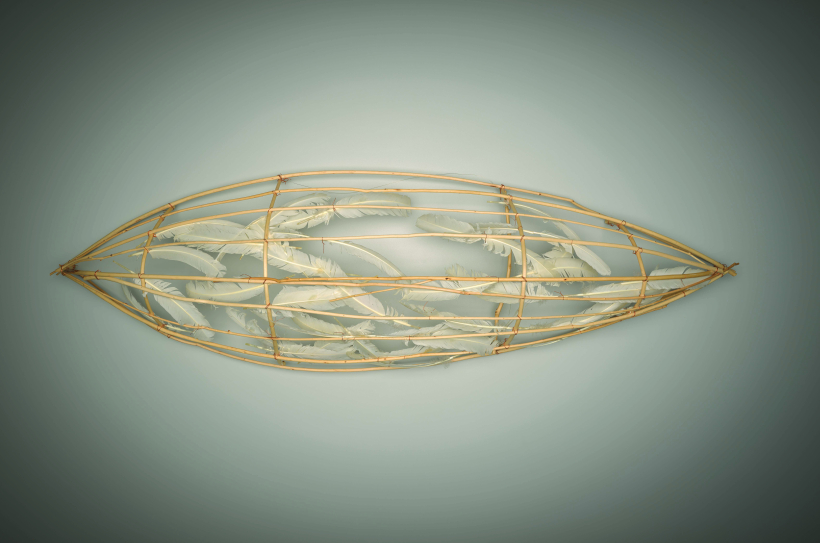The Smithsonian’s National Museum of the American Indian will open “Water’s Edge: The Art of Truman Lowe,” the first major retrospective of the acclaimed Hoocąk (Ho-Chunk) artist, at its museum in Washington, D.C. The exhibition opens to the public Oct. 24 and closes in January 2027.
This landmark exhibition brings together for the first time many of Truman Lowe’s (1944–2019) monumental sculptures and significant works from public and private collections, including 28 from the National Museum of the American Indian. Featuring nearly 50 of his sculptures, drawings and paintings, the exhibition surveys his career and the key themes he explored in his work. Lowe’s sculptures made of willow branches, feathers and other natural materials evoke the waterways of the Wisconsin woodlands where he was raised and the canoes used to traverse them. His work also considers human relationships to place and memory.
“Truman Lowe’s art reflects on the waters and woodlands of his home, as well as family and cultural traditions, memory and knowledge,” said Rebecca Head Trautmann, exhibition curator. “We are excited to share his work and his story with our visitors.”
The exhibition is organized around four intersecting themes: Moving Water, The Land Holds Memory, Woodland Structures and Memory and Shared Knowledge.
Moving Water
Raised near the banks of the Black River, Lowe developed a lifelong fascination with water that deeply influenced his work. Sculptures such as “Ottawa” (1992) and “Waterfall VIII” (2011) demonstrate his ability to convey the fluidity of water in wood. Drawings in charcoal and pastels, including his “Water Reflections” series, explore water’s surface reflections, soft ripples and changing colors.
The Land Holds Memory
Lowe felt a deep connection to the Wisconsin woodlands where he was raised—the homeland Hoocąk people had struggled to retain. While his “Totem” sculptures draw visually and conceptually on that forested landscape, the “Petroglyph Series” (1995) contemplates the knowledge and stories Indigenous people recorded in painted and incised drawings on rock walls.
Woodland Structures
Lowe also took inspiration from ancestral Hoocąk and neighboring Woodland people’s expertise with craft and construction. He admired the domed architecture of traditional dwellings and the forms of canoes. Lowe explored the design of the watercraft in works such as “Shadow Canoe” (1996) and “Feather Canoe” (1996).
Memory and Shared Knowledge
Lowe was interested in mnemonic devices and infused his work with Hoocąk and family knowledge, memories and creative practices. In 1996’s “Wa-Du-Sheh” (Bundle) he considered the ways people protect the things they value and preserve them for future generations. In drawings including “Sauninga” (1992), “Ribbon Appliqué” (ca. 1980) and “Untitled (Ribbonwork)” (ca. 1980), Lowe honors the creativity of his mother, Mabel Davis Lowe, and the story of her Hoocąk name, while other works draw on the knowledge of wood and its properties that he learned from his father.
Leading support for the exhibition is provided by Bank of America. Major support is provided by the Henry Luce Foundation. Generous support is provided by the Terra Foundation for American Art and Ameriprise Financial. Additional support is provided by John and Meryl Lavine, Greg and Cathy Tibbles and Leslie A. Wheelock.
About the Artist
As an artist, museum curator, university educator and mentor, Lowe influenced generations of emerging artists, scholars and curators. He left an enduring legacy to the fields of American and Native North American art.
An internationally exhibited artist, Lowe also taught sculpture for 35 years at the University of Wisconsin–Madison and was the founding curator of contemporary art at the National Museum of the American Indian. While there, he significantly expanded the museum’s contemporary art collection. In 2022, the University of Wisconsin–La Crosse, his undergraduate alma mater, dedicated the Truman T. Lowe Center for the Arts, which houses the school of visual and performing arts.
Celebrating the Art of Truman Lowe
On Saturday, Oct. 25, Trautmann will give a tour of the exhibition at 11 a.m. At 2 p.m., she will be joined by Lowe’s daughter Tonia Lowe (Hoocąk) and sculptor Michael Belmore (Anishinaabe) in the museum’s Rasmuson Theater for a conversation about Lowe’s artwork and its impact on Indigenous contemporary artists. It is free, and no tickets are required.
Exhibition Catalog
Water’s Edge: The Art of Truman Lowe celebrates the artist’s life and career in a retrospective featuring more than 100 images and intimate insights on his original and evocative sculptures and drawings.
The catalog explores the overlapping themes of moving water, woodland structures, memory and knowledge, and landscape and place that permeate Lowe’s work. Essays from scholars contextualize the art within his life, career and heritage, including the repeated expulsion of the Hoocąk people from their ancestral homeland and their resolve to return. In deeply moving reflections, fellow artists share their connections to Lowe, his influence on their lives and work, and his impact on American art.
In addition to featuring his work, Water’s Edge includes personal and historical photos of his family and studio to offer an intimate look at his influences and process.
About the Museum
In partnership with Native peoples and their allies, the National Museum of the American Indian fosters a richer shared human experience through a more informed understanding of Native peoples. Through two locations, it features exhibitions and programs in New York City and the National Mall in Washington, D.C. For additional information, including hours and directions, visit AmericanIndian.si.edu. Follow the museum via social media @SmithsonianNMAI.

